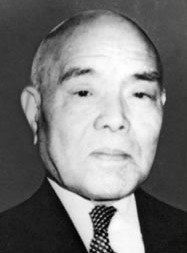Toshihiro Kennoki (Japanese: 剱木亨弘; 3 September 1901 - 29 November 1992) was a Japanese politician. Kennoki served as Minister of Education under Prime Minister Eisaku Satō from 1966 to 1967. He is credited for having been one of the central figures who helped drive the Central Council for Education.
Tohishiro Kennoki | |
|---|---|
剱木 亨弘 | |
 Kennoki in 1966 | |
| 88th/89th Minister of Education | |
| In office 3 December 1966 – 25 November 1967 | |
| Monarch | Hirohito |
| Cabinet | Eisaku Satō I Third Reformed Cabinet Eisaku Satō II |
| Preceded by | Kiichi Arita |
| Succeeded by | Hirokichi Nadao |
| Personal details | |
| Born | 3 September 1901 Ōtō, Fukuoka Prefecture, Japan |
| Died | 29 November 1992 (91 years old) |
| Political party | Liberal Democratic |
| Alma mater | Tokyo Imperial University Faculty of Law |
| Awards | Order of the Rising Sun |
Career edit
Kennoki joined the House of Councilors in 1953 with the goal of promoting education reform within the LDP. He was among a wave of more progressively-minded members of the National Diet, along with later Minister of Education Michita Sakata, that wanted to prioritize "policy over politics" when it came to education.[1]
Kennoki originally rose to prominence as a bureaucrat within the Ministry of Education, Science, Sports and Culture. He was interested in the field of primary education and education reform in general, and held the positions of Director of the Higher Education and Science Bureau within the Ministry and Vice Minister of Education.[2][3]
Right around the beginning of 1967, 20 years after the post-war Japanese education system was introduced, Kennoki was chosen as Minister of Education to try and reevaluate the educational system.[4] Kennoki had, beforehand, criticized the American system being imposed on Japan, describing it as a "trick" (karakuri) and blaming the education system on a conspiracy.[5] He believed that:
The Mission [referring to the United States Education Mission to Japan] was, I think, a clever ploy of the American Occupation policy. They organized a plan by which education matters were dealt with by a mission of educators and not by military officers, and arranged for the Japanese Education Committee to cooperate with them in order to produce a report that would be voluntarily accepted by the Japanese side.[6]
In July 1967, Kennoki requested for the Central Council for Education to look into the entire education system and provide new guidelines for it.[7] This request kicked off an investigation into the education system that would result in the Council's publishing of radical new guidelines in 1971, something that would define Japanese educational policy decades on. Kennoki recalled that the request was made by his own volition, and that he remembers that he only had one other LDP member look over it.[8]
In October 1967, Kennoki declared a militant strike by Nikkyoso (the Japanese teachers' union) over low wages imposed by the Satō government to be illegal, stating that he would only meet with the striking teachers if they renounced their Code of Ethics and did not use force to try and influence government policy.[9]
References edit
Citations edit
- ^ Schoppa 2002, p. 79-80.
- ^ Public Information Bureau, Ministry of Foreign Affairs 1966, p. 316.
- ^ Park 1986, p. 56.
- ^ Schoppa 2002, p. 46.
- ^ Schoppa 2002, p. 37.
- ^ Tsuchimochi 1999, p. 41.
- ^ Schoppa 2002, p. 3.
- ^ Schoppa 2002, p. 172.
- ^ Duke 2019, p. 185.
Bibliography edit
Books
- Duke, Benjamin C. (31 March 2019). Japan's Militant Teachers: A History of the Left-Wing Teachers' Movement. University of Hawaii Press. ISBN 978-0-8248-8080-4.
- Public Information Bureau, Ministry of Foreign Affairs (1966). Information Bulletin. Public Information Bureau, Ministry of Foreign Affairs.
- Schoppa, Leonard James (11 March 2002). Education Reform in Japan: A Case of Immobilist Politics. Routledge. ISBN 978-1-134-86516-1.
- Park, Yung H. (1986). Bureaucrats and Ministers in Contemporary Japanese Government. Institute of East Asian Studies, University of California, Berkeley, Center for Japanese Studies. ISBN 978-0-912966-84-7.
Articles
- Tsuchimochi, Gary H. (1999). "The Emergence of the New Four-Year University System in Postwar Japan". Nanzan Review of American Studies. 21: 41–60.